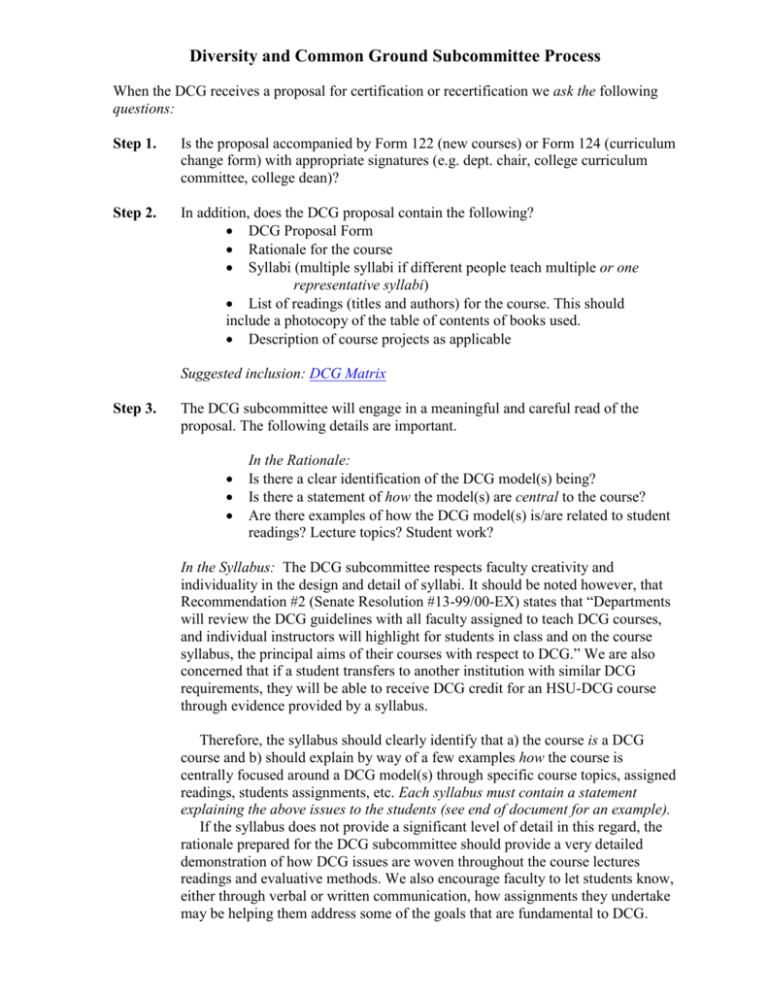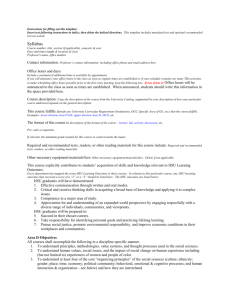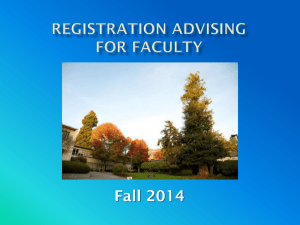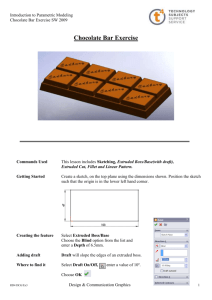Diversity and Common Group Subcommittee Process
advertisement

Diversity and Common Ground Subcommittee Process When the DCG receives a proposal for certification or recertification we ask the following questions: Step 1. Is the proposal accompanied by Form 122 (new courses) or Form 124 (curriculum change form) with appropriate signatures (e.g. dept. chair, college curriculum committee, college dean)? Step 2. In addition, does the DCG proposal contain the following? DCG Proposal Form Rationale for the course Syllabi (multiple syllabi if different people teach multiple or one representative syllabi) List of readings (titles and authors) for the course. This should include a photocopy of the table of contents of books used. Description of course projects as applicable Suggested inclusion: DCG Matrix Step 3. The DCG subcommittee will engage in a meaningful and careful read of the proposal. The following details are important. In the Rationale: Is there a clear identification of the DCG model(s) being? Is there a statement of how the model(s) are central to the course? Are there examples of how the DCG model(s) is/are related to student readings? Lecture topics? Student work? In the Syllabus: The DCG subcommittee respects faculty creativity and individuality in the design and detail of syllabi. It should be noted however, that Recommendation #2 (Senate Resolution #13-99/00-EX) states that “Departments will review the DCG guidelines with all faculty assigned to teach DCG courses, and individual instructors will highlight for students in class and on the course syllabus, the principal aims of their courses with respect to DCG.” We are also concerned that if a student transfers to another institution with similar DCG requirements, they will be able to receive DCG credit for an HSU-DCG course through evidence provided by a syllabus. Therefore, the syllabus should clearly identify that a) the course is a DCG course and b) should explain by way of a few examples how the course is centrally focused around a DCG model(s) through specific course topics, assigned readings, students assignments, etc. Each syllabus must contain a statement explaining the above issues to the students (see end of document for an example). If the syllabus does not provide a significant level of detail in this regard, the rationale prepared for the DCG subcommittee should provide a very detailed demonstration of how DCG issues are woven throughout the course lectures readings and evaluative methods. We also encourage faculty to let students know, either through verbal or written communication, how assignments they undertake may be helping them address some of the goals that are fundamental to DCG. Extra documentation (if provided): Feel free to provide handouts, descriptions of student projects and so on that further demonstrate the connection between student activities and DCG issues. Courses with Multiple Instructors: We recognize that not all faculty teach the same course in the same way. However, all iterations of the course must meet the “spirit” of the DCG guidelines. For the purpose of getting course certified or recertified as DCG, we will accept either of the two following options: a) One rationale with multiple syllabi. Please provide a rationale that covers all the syllabi being submitted for consideration. Each syllabus for the same course would need to include a statement that it is a DCG course and how the course meets DCG aims specifically. b) One rationale with one representative syllabus. Please provide a rationale that speaks to how DCG is incorporated throughout the course in general as well as specific examples from at least a few of the faculty who teach the course regularly. This rationale would be accompanied by ONE representative syllabus chosen by the department. In this type of submission, the proposer needs to explain how the department communicates with faculty who teach this course, and/or part time people who might be hired to teach the course in the future. One possible approach is that departments keep a binder with both the rationale and syllabi for approved DCG courses. There could also be a “minimum content statement” to clearly define what DCG-related concepts should be included. Variable Topics Courses A special problem could arise when variable or selected topics course numbers include courses for which DCG certification is desired. The DCG courses should probably be renumbered through the college curriculum committee for the purposes of the Registrar’s Office. If a cluster of courses that would meet DCG requirements were to be offered under the same number, the department could write a rationale that identified the possible topics. One exemplary syllabus could be submitted as detailed in Multiple Instructors “b’ above. Step 4. Based on our consideration of the proposal, we either approve the course as is for recertification, or, not uncommonly, we ask proposers to resubmit their proposal with additional documentation and/or clarification regarding the connections between class activity and DCG issues. If revisions are asked for, we also offer proposers an opportunity to come in and talk with the committee. * Asking for clarification SHOULD NOT be interpreted as a rejection of your course, but as our effort to have the most clearly articulated and strongest proposals/courses passed as possible. As future proposers ask for clarification on the process, we will be able to direct them to very clear, well-developed, and strong examples of courses that meet the new DCG guidelines. Step 5. Follow-up with faculty with offers of assistance. Step 6. The subcommittee evaluates the re-submitted proposals. Step 7. The subcommittee makes a recommendation for approval to the University Curriculum Committee. When the UCC approves the course, it then goes to the Undergraduate Studies office for final approval and vetting. Step 8. If the submitter and the DCG Committee cannot come to resolution regarding the status of the proposal, the submitter has the right to approach the University Curriculum Committee as a whole for resolution.






